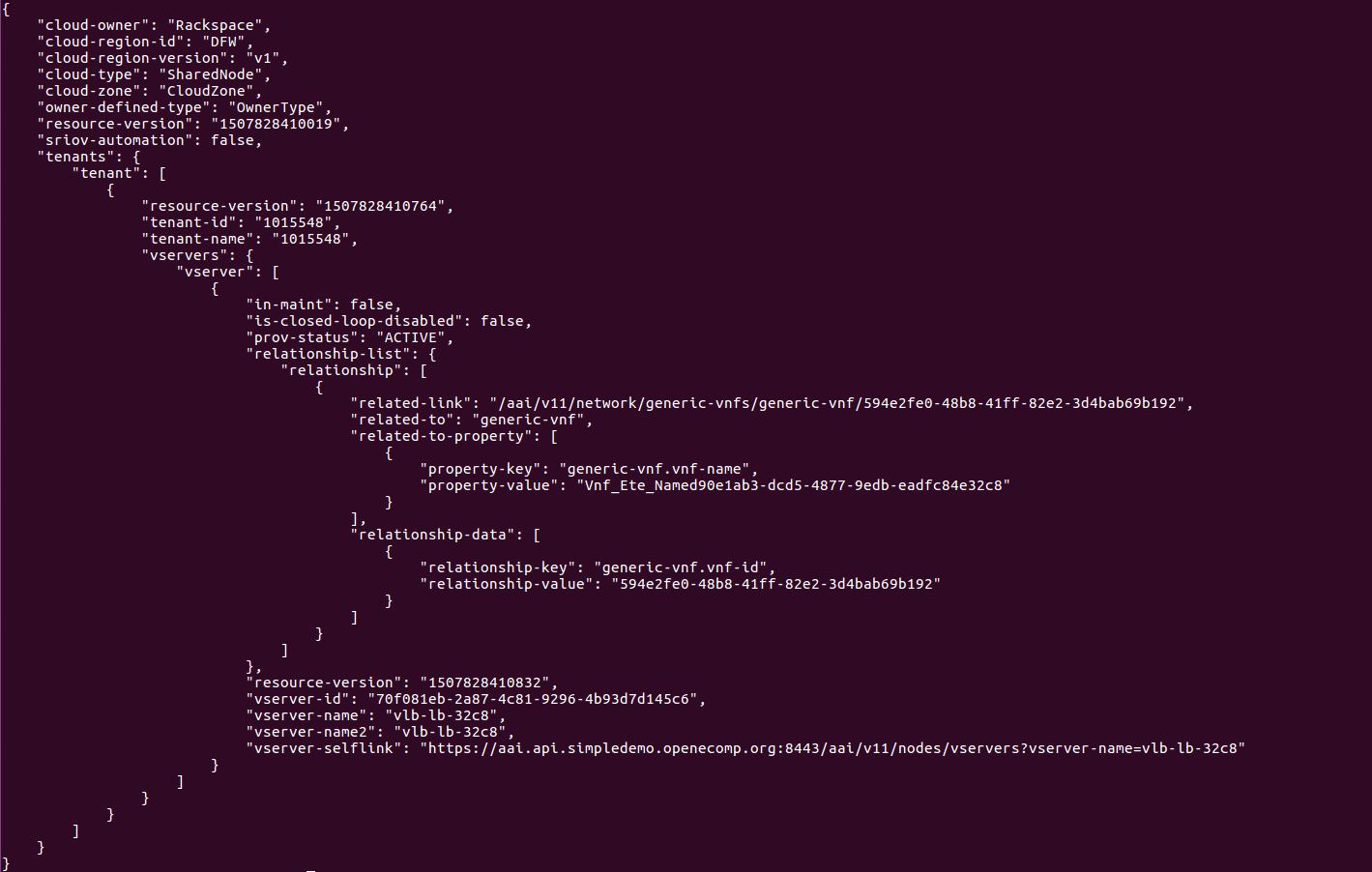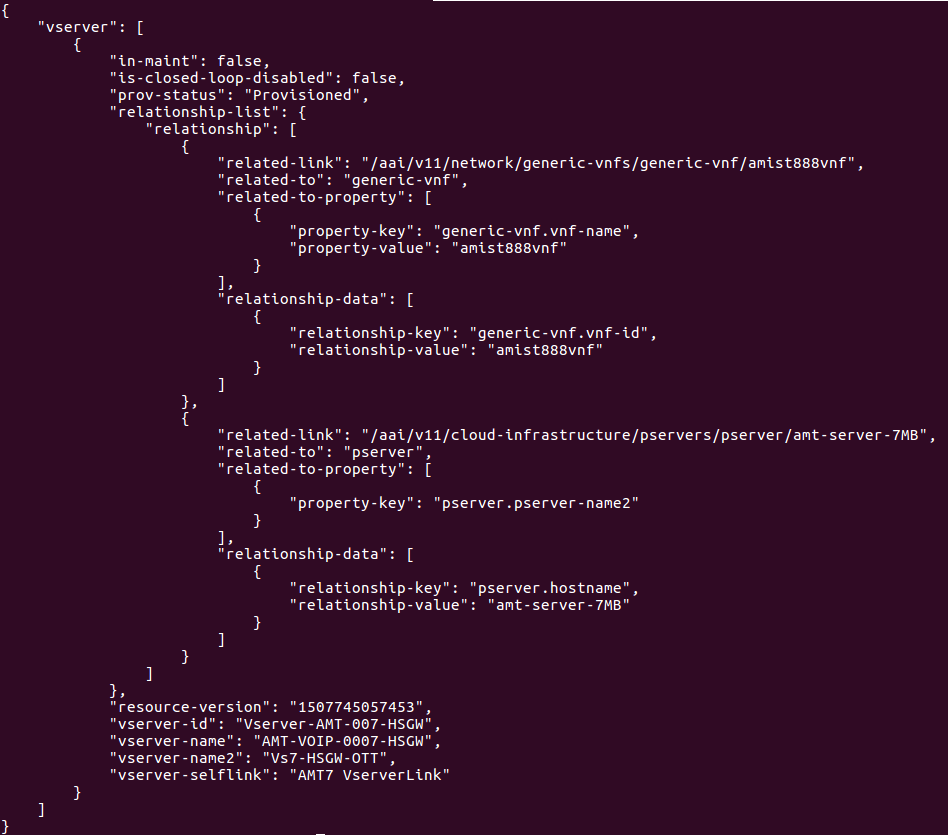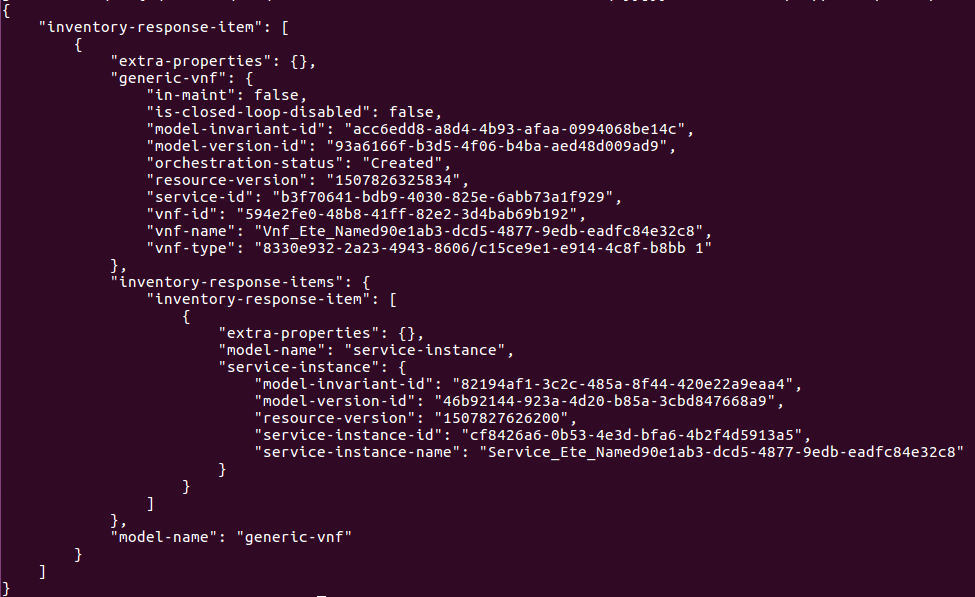Verifying/Modifying AAI Data¶
Contents
This page highlights key commands used by Policy to look at and modify A&AI data for testing purposes. Please refer to the A&AI REST API Documentation for more details.
Checking Current Data¶
To get all the vnfs that are in AAI¶
Use this command if you want to get all the vnf’s that are provisioned in A&AI. This is useful if you want to find a couple vnf’s you can later query.
curl --silent -k -u "<userName>:<password>" --header "X-FromAppId: <fromApp>" --header "Content-Type: application/json" --header "Accept: application/json" --header "X-TransactionId: <requestID>" -X GET https://aai.api.simpledemo.openecomp.org:8443/aai/v11/network/generic-vnfs | python -m json.tool
To get a specific vnf¶
If you have a vnf-id, this command returns the details related to the specific vnf id you are querying. Policy primarily does this query if the onset has a vnf id but not the isClosedLoopDisabled field.
curl --silent -k -u "<userName>:<password>" --header "X-FromAppId: <fromApp>" --header "Content-Type: application/json" --header "Accept: application/json" --header "X-TransactionId: <requestID>" -X GET https://aai.api.simpledemo.openecomp.org:8443/aai/v11/network/generic-vnfs/generic-vnf/<vnfID> | python -m json.tool
If you have a vnf-name, this command returns the details related to the specific vnf name you are querying. Policy primarily does this query if the onset has a vnf name but no vnf id.
curl --silent -k -u "<userName>:<password>" --header "X-FromAppId: <fromApp>" --header "Content-Type: application/json" --header "Accept: application/json" --header "X-TransactionId: <requestID>" -X GET https://aai.api.simpledemo.openecomp.org:8443/aai/v11/network/generic-vnfs/generic-vnf?vnf-name=<vnfName> | python -m json.tool
To find all the vservers¶
Follow these steps to get all of the vservers. This is useful to get a couple of vservers to query later, either manually or through a closed loop.
Step 1: Execute the following:
curl --silent -k -u "<userName>:<password>" --header "X-FromAppId: <fromApp>" --header "Content-Type: application/json" --header "Accept: application/json" --header "X-TransactionId: <requestID>" -X GET https://aai.api.simpledemo.openecomp.org:8443/aai/v11/cloud-infrastructure/cloud-regions | python -m json.toolTake note of all the cloud-owner/cloud-region combinations. In this example, there are 3 combinations: Skynet/CL-MR1, AMIST/AMCR1, and Rackspace/DFW.

Step 2: Invoke the following command for each combination:
curl --silent -k -u "<userName>:<password>" --header "X-FromAppId: <fromApp>" --header "Content-Type: application/json" --header "Accept: application/json" --header "X-TransactionId: <requestID>" -X GET https://aai.api.simpledemo.openecomp.org:8443/aai/v11/cloud-infrastructure/cloud-regions/cloud-region/<cloudOwner>/<cloudRegion>?depth=all | python -m json.tool
To get a specific vserver¶
Use this command to get the details of a specific vserver based on its vserver name.
curl --silent -k -u "<userName>:<password>" --header "X-FromAppId: <fromApp>" --header "Content-Type: application/json" --header "Accept: application/json" --header "X-TransactionId: <requestID>" -X GET https://aai.api.simpledemo.openecomp.org:8443/aai/v11/nodes/vservers?vserver-name=<vserverName> | python -m json.tool
Named-Queries¶
These commands are used to get more information than can be obtained in a single other query. They require more data to be sent in the query, but return information on the related instances of a given vnf or vserver, as well as the information about the vnf/vserver itself.
For vFW:
curl --silent -k -u "<userName>:<password>" --header "X-FromAppId: <fromApp>" --header "Content-Type: application/json" --header "Accept: application/json" --header "X-TransactionId: <requestID>" -d "{\"query-parameters\": { \"named-query\": { \"named-query-uuid\": \"a93ac487-409c-4e8c-9e5f-334ae8f99087\" } }, \"instance-filters\":{\"instance-filter\":[ {\"generic-vnf\": { \"vnf-id\": \"<vnfID>\"}}]}}" -X POST https://aai.api.simpledemo.openecomp.org:8443/aai/search/named-query | python -m json.tool
For vDNS:
curl --silent -k -u "<userName>:<password>" --header "X-FromAppId: <fromApp>" --header "Content-Type: application/json" --header "Accept: application/json" --header "X-TransactionId: <requestID>" -d "{\"query-parameters\": { \"named-query\": { \"named-query-uuid\": \"4ff56a54-9e3f-46b7-a337-07a1d3c6b469\" } }, \"instance-filters\":{\"instance-filter\":[ {\"vserver\": { \"vserver-name\": \"<vnfID>\"}}]}}" -X POST https://aai.api.simpledemo.openecomp.org:8443/aai/search/named-query | python -m json.tool
Adding Data to A&AI¶
Generic-Vnf¶
curl --silent -k -u "<username>:<password>" --header "X-FromAppId: POLICY" --header "Content-Type: application/json" --header "Accept: application/json" --header "X-TransactionId: 8611ece5-5786-4e71-b72f-e87ef44029da" -X PUT -H "Content-Type: application/json" --data @addVnf.txt https://aai.api.simpledemo.openecomp.org:8443/aai/v11/network/generic-vnfs/generic-vnf/<vnfID> | python -m json.tool
The addVNF.txt file is just the data you would like to add. At minimum, the vnf-id, vnf-name, vnf-type and is-closed-loop-disabled fields need to be filled out, and the vnf-id needs to match the one you choose in the url of the curl command.
Vserver¶
curl --silent -k -u "<username>:<password>" --header "X-FromAppId: POLICY" --header "Content-Type: application/json" --header "Accept: application/json" --header "X-TransactionId: 8611ece5-5786-4e71-b72f-e87ef44029da" -X PUT -H "Content-Type: application/json" --data @addVserver.txt https://aai.api.simpledemo.openecomp.org:8443/aai/v11/cloud-infrastructure/cloud-regions/cloud-region/<cloud-owner>/<cloud-region-id>/tenants/tenant/<tenant-id>/vservers/vserver/<vserver-id>
The addVserver.txt file is the vserver object you would like to add. It needs values for vserver-id, vserver-name, vserver-selflink, in-maint, and is-close-loop-disabled at minimum. The values of <cloud-owner>, <cloud-region-id>, and <tenants> depends on the values already in Rackspace, see the section above under finding all Vservers.
Named Queries¶
The data for the named queries is based off of the data in the relationship-list field for both vservers and vnfs.
End of Document